
Chicago deep dish pizza. Photo courtesy Giordano’s
By the thousands they came, between 1880 and 1920, fleeing poverty and starvation in Southern Italy to power America’s factories, build roads and dig tunnels.
Like every wave of newcomers, the hard-working Italians found comfort in recreating the familiar recipes and cooking techniques they’d left behind.
Little did they know la pizza, the humble flat circle of fresh-baked bread that fed their families, topped with a little cheese, perhaps an anchovy fillet or a dollop of tomato sauce, would become an international sensation, elevated to gourmet status, inspiring competitions and fueling rivalries among cities like Detroit, New York, Chicago, New Haven, all the way to LA.
“Everybody loves pizza,” says Steve Dolinsky, Chicago’s Pizza Guy. “You can be a child, adult or elderly, you can be vegan, gluten-free, a meat lover or a crust lover, pizza checks all the boxes and satisfies any craving, any time.”
MOTOR CITY SECRET
“With every bite of pizza you’re eating a slice of history,” says Detroit reporter and author Karen Dybis, who published Detroit Style Pizza A Doughtown History in 2023. “You can still find sit-down restaurants opened by immigrants that serve handmade pizza from recipes that go back decades.”
Dybis recounts the story of Gus Guerra, hailed as the father of Detroit’s now world-famous square pizza. In 1946 Guerra bought into his family’s bar, Buddy’s, which you can still visit at Six Mile and Conant on the city’s east side. To boost profits, his wife and mother-in-law crafted a traditional Sicilian-style sfincione cut in squares to offer as a snack with drinks.
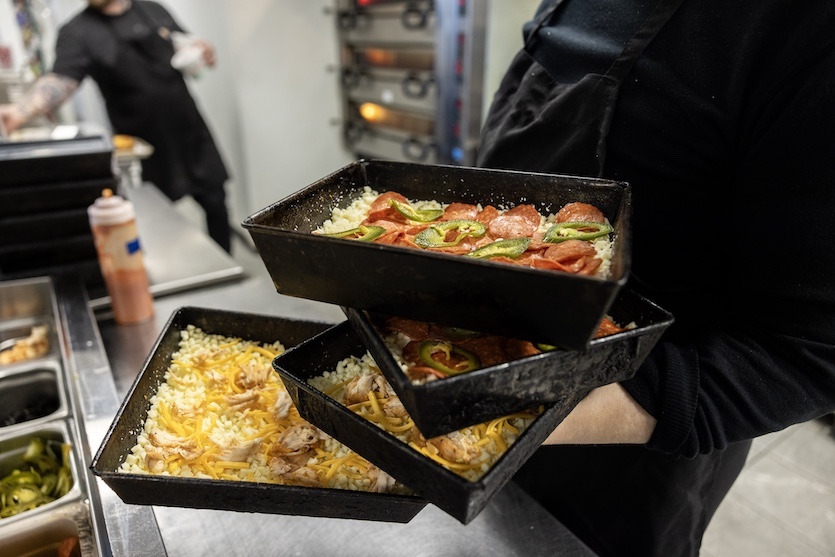
Detroit’s square-shaped deep-dish pizza comes from deep rectangular pans appropriately sized for the Motor City. Photo courtesy of Michigan & Trumbull pizzeria
“It was an instant hit,” says Dybis. “People loved its unique style.”
Pizza lovers accustomed to the blistered, thin-crust Neapolitan pie born in Naples, on Italy’s west coast, in the 1700s as a cheap fast food, will find Detroit pizza a revelation. The first difference is its shape. The dark rectangular steel pans used to bake Detroit pizza look like they came from an auto plant. Dybis debunks the story of Sicilians swiping pans from work to make the city’s first pizza. According to her interviews with family members, who went on to open several more famous Detroit pizzerias, including Loui’s and Cloverleaf (a former Irish pub), Guerra may have purchased them from a local hardware store.
Detroit’s pizza masters press a thick layer of dough into the bottom of the well-oiled pan and let it rest for an airy focaccia-like crust. The dough is then topped with a shocking amount of grated mild brick cheese from Wisconsin spread right to the edge. On go the toppings – anchovies, onions and breadcrumbs were favorites on the original sfincione. As a finishing touch, tomato sauce is dolloped or ladled on top to resemble racing stripes.
In the oven, the magic happens. As the cheese melts it caramelizes against the sides of the pan to form a dark, lacey crust called frico. “Be prepared to fight over the crust because everybody wants that crispy corner,” says Dybis. “Some places offer two smaller pizzas so you get the same number of slices but more cheesy edges.’’

If your deep-dish pizza looks like edible art you must be at Detroit’s Michigan & Trumbull. Note the lacey “fricoe” crust on the pizzas. Photo by Cynthis David
For decades, the “square” pies were practically a local secret, shared with friends and family. That all changed in 2012 when a Detroit-style pizza (DSP) made by delivery driver-turned-Cloverleaf Pizza owner Shawn Randazzo earned him the World Champion Pizza Maker of the Year award at the International Pizza Expo competition in Las Vegas. Suddenly, the entire world wanted to taste the upside-down pizza with sauce on top.
Inspired by his win, Randazzo and his mother started their own company and shared their knowledge with other pizza-curious restaurateurs. Today, with a nudge from social media, Motown’s square pies are pulled from ovens in Toronto, Mexico City, London, Berlin, Seoul, Dubai and Adelaide. Michigan-born chain Little Caesar’s added a DSP to its menu in 2013.
Like Randazzo, Detroit-born chef Nate Peck is pleased to share his love of pizza with visitors. At 5 a.m. most mornings you’ll find him in the stainless-steel kitchen of his small, quirky restaurant Michigan & Trumbull, mixing dough and pressing it into more than 200 rectangular pans before wheeling them into the cooler to proof overnight and develop flavor. “I’m obsessed with the dough,” says Peck, “and constantly think about how to improve it.”
His current location, a handsome red brick building not far from the Motown Museum and the Henry Ford Hospital, is part of a complex that built Ford’s Model T sedans in the 1920s.
“For me, pizza is comfort food,” says Peck. Like the city’s original Italian immigrants, he began making and selling his own Detroit Style Pizza when he moved to Pittsburgh with wife and co-owner Kristen Calverley and realized how much they both missed Jet’s Pizza, the chain they grew up with.
Moving back to Detroit in 2019 to compete against the city’s pizza legends was daunting, he says, but his fine-grained artisanal crust and fresh, seasonal toppings quickly earned him a loyal following. Bestsellers include the Packard Pepperoni, with tomato sauce, pickled chiles and a drizzle of spicy honey, and the Farnsworth Funghi, a “white” pizza topped with roasted mushrooms, whipped goat cheese, arugula and garlic oil. Though not mentioned on the menu, Peck is happy to top each six-square pizza with two sets of toppings if you can’t decide between them. Mitchell & Trumbell may also be the only restaurant in The D where you can order an appetizer of roasted baby carrots and sample dill pickle pizza, a recent monthly special.

Detroit co-owner Nate Peck is preparing pizza at Michigan & Trumbull. Photo by Cynthia David
GRAB A SLICE IN NYC
Start spreading the news, New York offers a taste of every pizza style on the planet. Just ask Adam Kuban, who’s been talking pizza online since 2003 and helped found Serious Eats and SliceNY.com, one of the internet’s first pizza blogs.
“Every pizza style is represented in New York,” says Kuban, “from Detroit to Sicilian to Grandma-style.”
Like every pizza-loving US city, he says New York’s has evolved over generations. America’s first pizza joint, Lombardi’s, began selling tomato pies in New York City in 1905. Immigrant-owned pizzerias began popping up in cities across the country. The end of Prohibition 1933 brought a boom in storefront restaurants selling beer and pizza, while soldiers who’d served in Italy during World War II were thrilled to find their new favorite snack at home.
Along the way, the Big Apple created its own style, Kuban notes. It evolved from the thin-crust Neapolitan pizza, flash-baked in a sizzling wood-fired oven by Italian workers from Naples who landed in lower Manhattan in the early 1900s. Today’s version – served by the slice – is baked in rounds 16 to 20 inches across with a thin, crisp yet flexible crust, flavorful and oozy (not rubbery) cheese and sauce as simple as crushed tomatoes sprinkled with salt or a few herbs.

New York pizza is most often sold by the slice to accommodate citizens’ “grab it and go” lifestyle. Photo by Adam Kuban
“Order a slice in a slice shop and it’s served on a paper plate and eaten while walking down the street,” says the pizza nerd. To order like a native, request a plain or regular slice, aka cheese pizza. Asking for pepperoni is acceptable, he says, and vegetarians favor mushrooms, peppers and/or onions on top. “Anything more than that is getting outrageous.”
When asked where to taste the quintessential New York slice, Kuban doesn’t hesitate. “Go to Joe’s.”
Joe Pozzuoli, an immigrant from Naples, opened Joe’s Pizza 50 years ago in Greenwich Village. Like Buddy’s in Detroit, it remains an institution frozen in time: brick walls adorned with photos of celebrities, a tile backsplash, oven doors opening with a creak and closing with a bang. “There’s usually a line-up and a lot of action and noise at all hours,” says Kuban. “They make the pizza right there behind a glass partition so you always get a fresh, hot slice that hasn’t been sitting around.”
For a more elevated New York slice, try Scarr’s Pizza on the Lower East Side, which nabbed second place on Time Out magazine’s list of best pizza in the world for 2025.
“Scarr’s is fantastic,” says Kuban. “They mill their own flour in the basement and you can sit down surrounded by fashionistas, models and musicians.”
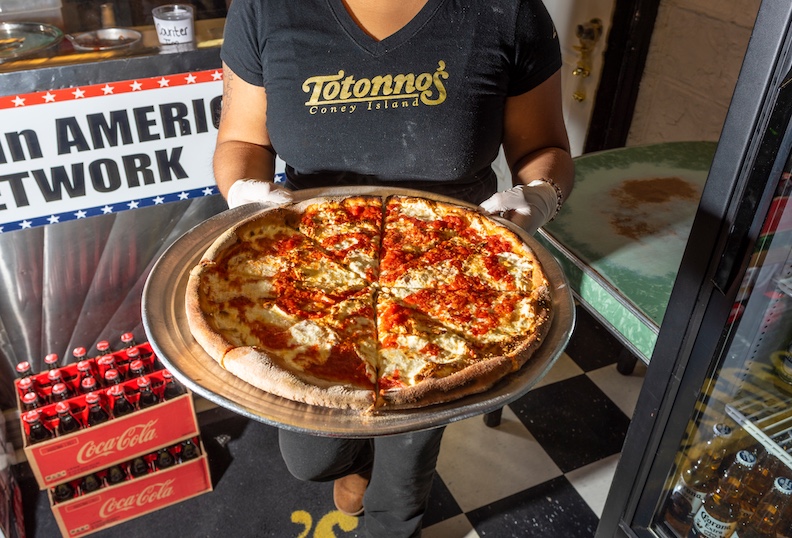
Coney island pizzeria Totonno’s has been operated by the same family since 1924 through fire, Hurricane Sandy and the pandemic. Their pizza, still baked in a coal oven, is now only available on weekends for takeout. Photo courtesy New York City Tourism
Between 2007 and 2013, Kuban says the city became so saturated with classic Neapolitan pizza, known for its limp center, interest began to wane. At that very moment, New York chef Matthew Hyland and wife Emily were perfecting their version of Detroit pizza, infusing the thick, fluffy crust and ultra-cheesy interior with what they called “Brooklyn Soul.” Rumor has it that the couple deconstructed a pile of Buddy’s pizzas for inspiration. However they conducted their research, the first “Emmy Squared” burst on the scene in 2016 and hasn’t looked back. “I love the cheese border,” says Kuban. “That frico edge is fantastic.”
New Yorkers also take pride in home-grown Grandma pizza, attributed to a pizza parlor in Long Island. This is the pizza an Italian Nonna without a fancy pizza oven would bake at home. Like the Sicilian it’s baked in a square or rectangular pan, but the dough is sprinkled with toppings and baked immediately, not left to rise, creating a thin, crisp crust. Kuban’s favorite places to try it: Adrienne’s Pizza Bar in the financial district, Il Porto in Brooklyn, and Best Pizza in Williamsburg.
When he’s in the mood for Sicilian, Kuban heads to L&B Spumoni Gardens in Brooklyn or Famous Ben’s Pizza of SoHo.
“As far as pizza cities go,” he says, “I think New York is one of the best, if not the best.” Over the past 15 years he’s watched pizza-preneurs become more inventive, playing with the all-important dough and creating toppings like pepperoni drizzled with spiced honey that quickly swept the world thanks to the internet.
GO DEEP IN CHICAGO
In 2017, while watching a late-night talk show, Steve Dolinsky was drawn to an item about his city’s deep-dish pizza. He quickly realized the graphic shown in the background wasn’t deep dish, it was a stuffed pizza, a different recipe and his least favorite. “It’s like comparing apples and oranges,” says the popular Chicago TV food reporter, who decided then and there to set the record straight. He became The Pizza Guy, writing books, conducting Pizza City USA tours and organizing pizza festivals.
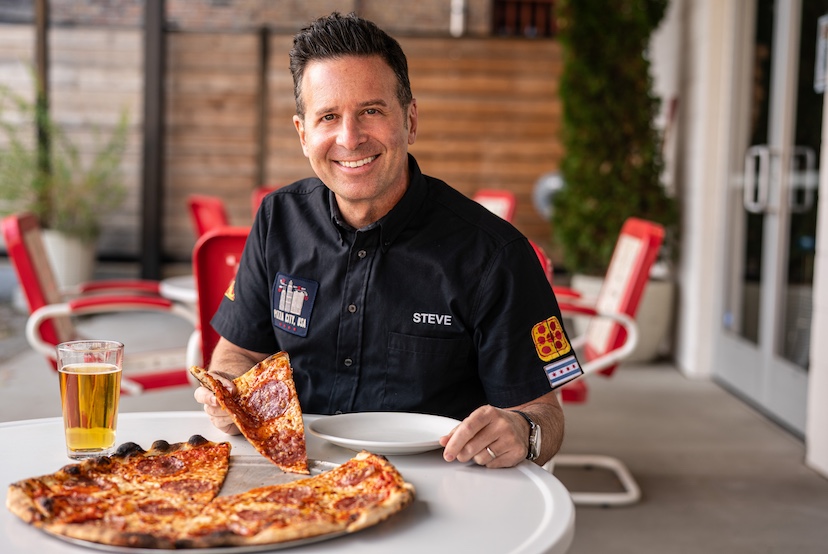
Chicago food reporter Steve Dolinsky samples a slice at Lobo Pizza. Photo by Todd Rosenberg Photography
“In Chicago we’re more about heartier styles,” Dolinsky says. “We tend to sit down and share a pie with family as opposed to New York where you’re typically on the go and having a slice by yourself at the counter.” If you like your pie meaty, he says, the Windy City prefers sausage to the wimpy pepperoni coins beloved on the East Coast. “You pick up a mass of fat, fennel-scented sausage and pinch it on top of the pie.”
To assess good pizza, the veteran reporter created a test called the Optimal Bite Ratio (OBR). “When I bite into a pizza, I want to taste equal amounts of cheese, sauce and toppings with every bite.”
Donning his tour guide hat, The Pizza Guy takes us through Chicago’s four styles of home-grown pizza. The oldest is Chicago thin, also known as tavern style or party cut. In the 1940s, the city’s 77 neighborhoods each boasted a local tavern. New gas ovens provided the perfect temperature for a round pizza with a thin, crisp crust that could be cut in squares and passed around free as a bar snack. Like Midwest tapas, the salty snack encouraged patrons to drink more beer. The idea quickly spread through the city. Nearly a century later, Vito & Nick’s Pizzeria is still turning out tavern-style pies.
Dolinsky says deep dish pizza, the city’s calling card, was created in 1943 at a bar called The Pizzeria in Chicago’s River North area. Owners Ric Riccardo and Ike Sewell began pushing dough into cake pans, patting it thin on the bottom and up the sides before adding toppings and tomato sauce. The crisp but tender pie was such a hit, the pair opened a second restaurant across the street in 1955 to handle the overflow. They renamed the original Pizzeria Uno and called its cousin Pizzeria Due. Both continue to thrive and attract visitors from around the world. At one point manager Lou Malnati tried to buy into the business but was rebuffed. In 1971 he opened his own pizza place in the suburbs. The Lou Malnati’s chain has since mushroomed into 70 locations in several states, most in Illinois. Gino’s East is also famous for deep-dish pies.
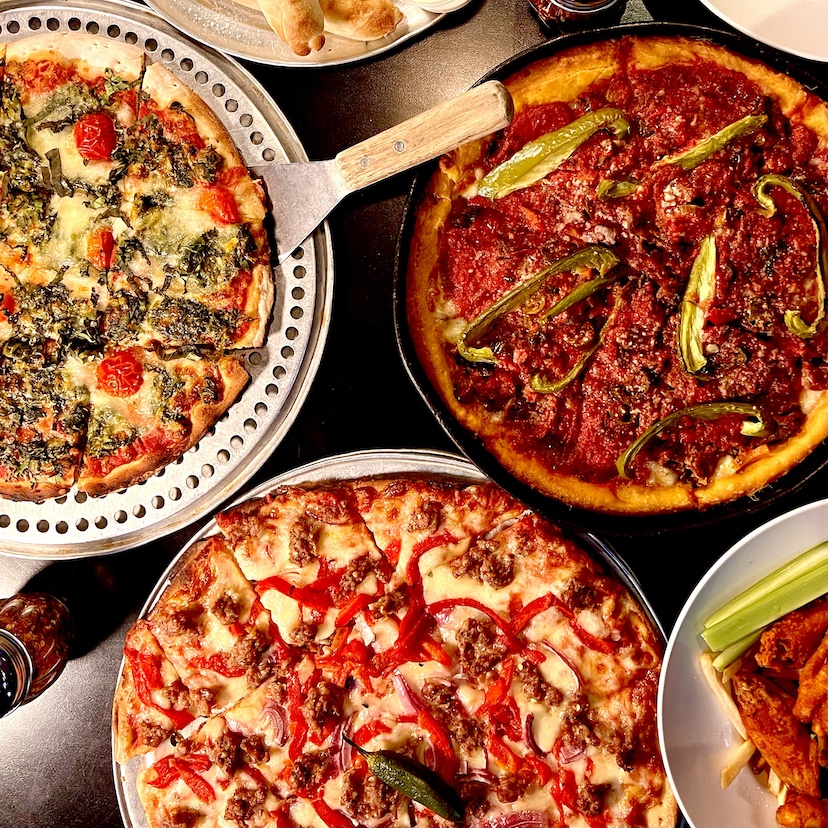
Chicago’s Gino’s East is famous for deep-dish pies. Photo courtesy of Choose Chicago
To make the third style, deep pan pizza, the chef gently presses dough into the pan then lets it proof for hours before adding toppings and baking. This creates a thicker, cushier crust than deep dish. Both require a knife and fork. Dolinsky recommends ordering deep pan at Pequod’s, Milly’s, Labriola or Burt’s Place in the Chicago suburb of Morton Grove.
Last but not least, meet stuffed pizza. In 1971, Rocco Palese, who owned a thin pizza joint called Guy’s, decided to take a traditional Italian Easter pie (torta rustica), stuffed with salami, eggs, ricotta cheese, whatever ingredients he had on hand, and turn it into a pizza by ladling tomato sauce over the top crust. He even gave the new arrival its own restaurant, named Nancy’s for his wife Annunziata. The hearty pie became a huge success, much to the Pizza Guy’s chagrin.
“Since the top crust never touches the cheese or the toppings, it has the texture of a cooked noodle,” says Dolinsky. “That’s a fail for me. Yet stuffed pizza has sucked the oxygen from the room. Tourists come to Chicago and eat stuffed and think they’ve had deep dish,” he says. “If they don’t like it, that’s it! They don’t even try tavern style, which has seen a resurgence in the last two years. If I polled 10 people in Chicago seven or eight would say they prefer thin pizza.”

Tourists on the Chicago Pizza City USA tour pause between slices at Pat’s Pizzeria. Photo by Steve Dolinsky
PAZZO FOR PIZZA
The historic port of New Haven, CT, has been pazzo (crazy) for pizza for more than a century, when bakers newly arrived from Southern Italy began making pizza along with bread. The city still claims the highest percentage of Italian Americans in the nation, 21% at last count, and proudly hosts three of the country’s oldest and most famous pizzerias.
Colin Caplan, local historian and founder of Taste of New Haven food tours, has spent 15 years researching and documenting Italian immigration while rallying his beloved city behind its favorite food, pizza!
In May 2024, Caplan pulled off his biggest culinary caper yet, joining a planeload of locals, officials and pizza makers bound for Washington to witness their state congresswoman declare New Haven as Pizza Capital of the United States and Connecticut as The Pizza State. This feat, which elicited much grumbling from other cities, is now immortalized on interstate highway signs and local license plates. The state has even launched a 100-stop Pizza Capital Trail with New Haven eateries leading the way.

Dozens of Connecticut residents traveled to Washington, DC to celebrate their state’s being named “The Pizza State” while New Haven was honored as America’s Pizza Capital. Photo by Colin M Caplan
Caplan’s perfect New Haven pie is thin and crisp with a chewy crust charred on the sides and top in a coal-fired brick oven heated to about 620℉. Some say the char imparts a bitter flavor, while others liken it to smoky barbecue. Just don’t call it burnt!
“I’d be looking for a layer of crushed tomatoes cooked into the pizza while it bakes,” he continues, “with pecorino romano cheese on top – slightly tart and sweet – and salty anchovies, aleej we say.”
In case you’re wondering, the city has adopted the language of pizza introduced by its original Italian workers. La pizza became apizza, pronounced ah-beetz. If you can’t imagine pizza without mozzarella, offered as an extra topping here, put on your best Tony Soprano accent and ask for mooz, or mooz-a-rell.
While most New Haven pizzerias switched to gas or oil-fired ovens in the late 1960s, Frank Pepe Pizzeria Napoletana (celebrating its 100th anniversary this year) and Sally’s Apizza, on Wooster Street, the heart of the city’s Little Italy, still cook with coal. The third legend, Modern Apizza, switched to gas but maintains its place in history.
Pepe (pronounced Pepee!) is also credited with inventing the clam pie. “Italians love seafood,” says Caplan. “Frank’s serves a white (tomato-free) pizza with olive oil, grated pecorino, chopped garlic, oregano and fresh-shucked littleneck clams from Long Island Sound. It’s a New Haven thing.”
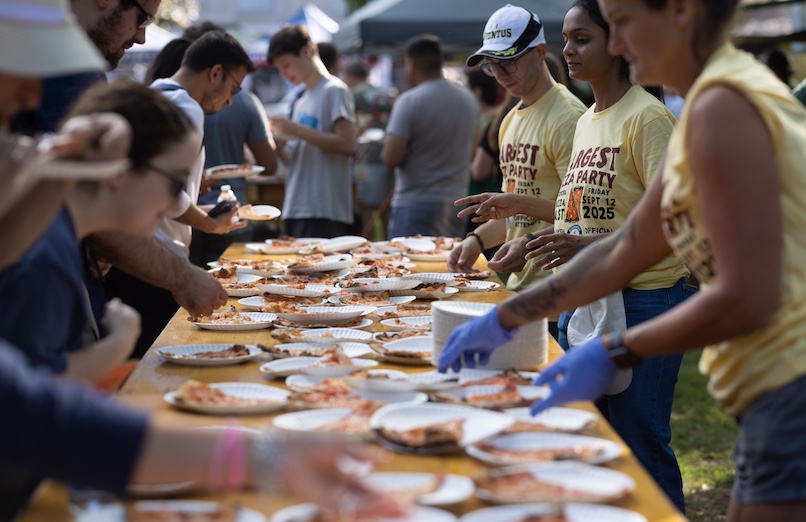
In May 2025, more than 4,500 participants, including Yale University students, attended an “Ah-Beetz Feast” hosted by Taste of New Haven food tours. So many pies were consumed that they broke the Guinness World Record for the world’s largest pizza party. “The Guinness event gave us another wave of positive attention,” says local historian Colin Caplan. “Pizza is something we do really well; we are the pickiest pizza eaters you’ll ever meet.” Photo by Chris Randall
Another signature dish is the mashed potato pizza, invented at Bar Brewpub. “Now everybody does it,” he says. “It’s spread with a thin layer of buttery mashed potatoes, mozzarella and crumbled bacon or strips. It’s got texture and a buttery flavor … I’m okay with it.”
If you visit New Haven, be sure to take a pizza tour, order a clam pie and check out the new exhibit at the New Haven Museum: Pronounced Ah-Beetz. Among the displays is one on the city’s invention of the pizza delivery box back in the 1930’s.
If you happen to end up in New York instead, Adam Kuban advises heading to John’s at Bleeker for a traditional coal-fired pie. “Tourists love it because it looks the part of a New York pizzeria from the 1960s,” he says. “There’s a Neon sign in the window, and you’re encouraged to scratch your name in the old wooden booths. They’re a little bit gruff, the way people expect New Yorkers to be, not mean just gruff.”
WEST COAST BUZZ
After organizing three wildly successful Pizza City Fests in Los Angeles, Chicago’s Pizza Guy is a huge fan of the city’s burgeoning pizza scene.
“It may sound crazy but right now LA is this beautiful, creative Petrie dish of incredible pizza-making,” says Dolinsky. “They have talented bakers who worked in cities like San Francisco and New York and moved back. There’s a Detroit-style place called Quarter Sheets in Echo Park, there’s Appollonia’s Pizzeria, Paisano’s … so many great places that nobody knows about.”
San Francisco, too, appears to be mad for pizza. Since most of the Italians who landed in California hailed from Northern Italy, not known for its pizza, Bay Area chefs are free to adopt other styles and create their own toppings using the state’s abundant fresh produce. For which they can thank the Italians, who played a major role in California’s thriving agriculture and wine industries.
“Basically, we have all kinds here – Detroit, New York, Naples (Italy not Florida), Connecticut, etc., but not a true SF pizza,” says book editor and former restaurant critic Sharon Silva. “Chefs seem to concentrate on the dough, making it their own, and on the toppings, making them very California.”
One of the city’s hottest new pizza places, Jules in the Lower Haight, opened this spring with a seasonal pie called Field of Dreams, composed of corn, bright orange cherry tomatoes and a Thai basil and serrano sauce on a thin New York-style sourdough crust. Six months later, “it’s still impossible to get a reservation,” says Silva.
“Pizza is definitely having a moment.”
Cynthia David is a freelance food and travel journalist based in Toronto who enjoys Pizza Napoletana in Naples, Italy. The former newspaper food editor has been published in leading Canadian newspapers and magazines. Her last story for EWNS examined the history and global popularity of Turkish coffee

